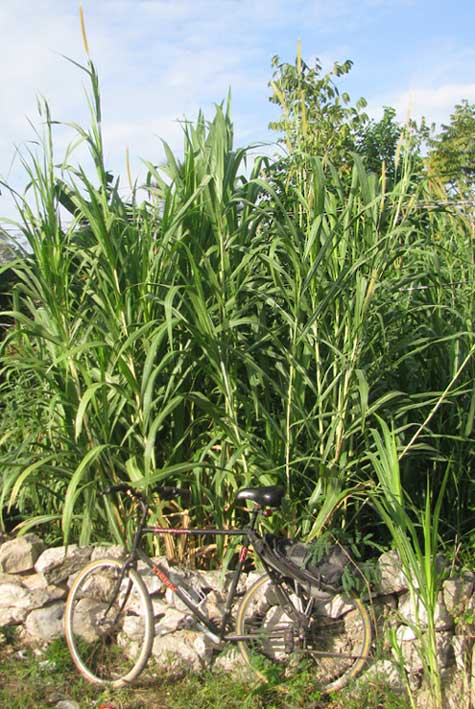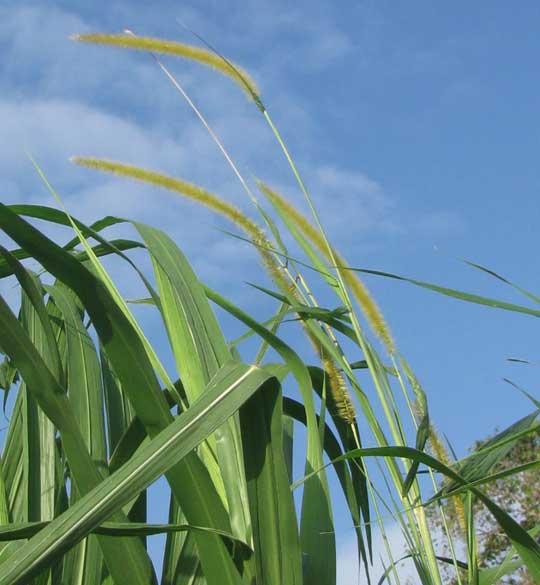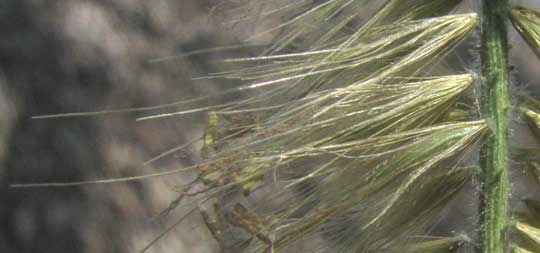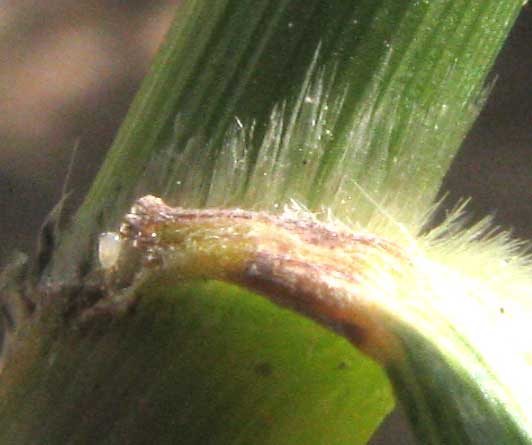Excerpts from Jim Conrad's
Naturalist Newsletter
from the January 22, 2012 Newsletter issued from Hacienda Chichen Resort beside Chichén Itzá Ruins; limestone bedrock; elevation ~39m (~128ft), N20.675°, W88.569°; central Yucatán state, MÉXICO
ELEPHANT GRASS
In an overgrown abandoned lot at a street corner in Pisté, 12-ft-tall (3.7m) bunches of grass are surprisingly green here in the dry season, as shown below:

Overtopping the stems and blades the slender, spikelike inflorescences bend in the wind, as seen below:

The slender, spikelike inflorescences are very unlike like the broad, feathery panicles of Pampas-Grass, Giant Reed or any of the other very large ornamental clump-grasses, and the stems and leaves are too broad and stiffly erect to be similar to the Sand Cordgrass we saw on the coast this summer. Fact is, if you know your grasses, the slender, very fuzzy inflorescences shown in the last picture could belong to one of the North's abundantly weedy foxtail grasses, though who has ever seen a 12-ft-tall foxtail grass? The close-up of some bristle-based florets arising from their hairy rachis seems to support the foxtail theory below:

However, when you thump a mature head of the grass in the picture, something happens proving that this isn't a foxtail grass: When foxtail grass flowers come off their rachis, just the basic oval flower departs while the stiff bristles remain behind on the rachis. When flowers in the picture fall off, the bristles go with the flowers. We don't have a giant foxtail grass here.
What we do have is a grass originally from Zimbabwe in subtropical Africa, but now planted and escaped as a weedy invasive in most of the world's tropical and subtropical countries. It's PENNISETUM PURPUREUM, among whose many English names Elephant Grass and Napier Grass seem to be the most commonly used. One reason the species is planted so broadly is that it produces a very extensive root system, so it survives droughts as well as dry seasons like ours, and heavy grazing. Also when provided with adequate water and fertilizer it provides an enormous amount of plant bulk for hay and silage.
In fact, an FAO page on the species describes it as one of the "most valuable forage, soilage and silage crops in the wet tropics." A 1978 study found that 2½ acres (1ha) of Elephant Grass could provide enough forage to produce three tons of live-weight gain in Zebu-type cattle.
So, at that rather seedy looking street corner in Pisté, what at first glance is nothing more than an overgrown, abandoned lot turns out to be a refuge for one of the world's most useful and productive grasses.
Elephant Grasses are so large that some of its anatomical features that in smaller species are too small to draw attention are very apparent. For example, take a look at Elephant Grass's "ligules" below:

In that picture the vertically slanted cylinder is the grass's stem, or "culm," while the flatish, pale item curving off horizontally to the right is the leaf blade. The fencelike row of slender, stiff, sharp hairs arising where the blade meets the culm is the ligule.
Not all grasses have ligules. Ligules come in two basic types: hairy like ours, or as thin, papery sometimes cellophane-like walls. Ligules can be very short or long. During grass identification, ligules can be important because species within a genus tend to have the same basic ligule type.
What are ligules for? Obviously they're not critically important, because many grass species don't have them.
For one thing, imagine a stem-eating bug on the leaf in the picture, approaching the stem. If the bug wants to burrow into the stem, the Elephant Grass's sharp- pointed ligule hairs will provide at least some protection. Ligules of the cellophane wall type might keep disease organisms gathering at the juncture of blade and stem from infecting the stem.